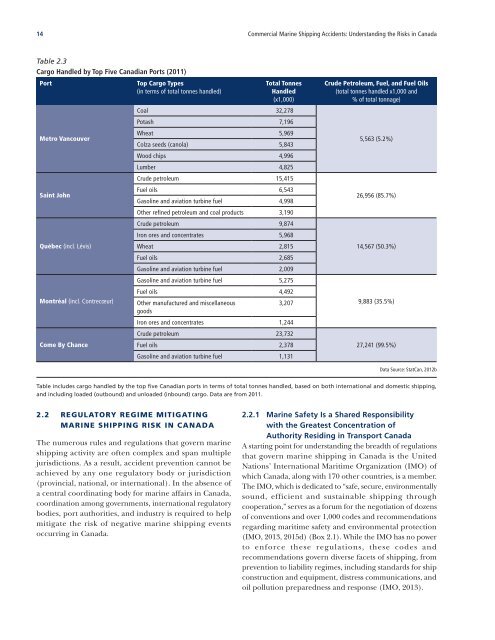Commercial Marine Shipping Accidents Understanding Risks Canada
cca_marine_shipping_risks_en_fullreport
cca_marine_shipping_risks_en_fullreport
Create successful ePaper yourself
Turn your PDF publications into a flip-book with our unique Google optimized e-Paper software.
14 <strong>Commercial</strong> <strong>Marine</strong> <strong>Shipping</strong> <strong>Accidents</strong>: <strong>Understanding</strong> the <strong>Risks</strong> in <strong>Canada</strong><br />
Table 2.3<br />
Cargo Handled by Top Five Canadian Ports (2011)<br />
Port<br />
Top Cargo Types<br />
(in terms of total tonnes handled)<br />
Metro Vancouver<br />
Saint John<br />
Québec (incl. Lévis)<br />
Montréal (incl. Contrecœur)<br />
Come By Chance<br />
Total Tonnes<br />
Handled<br />
(x1,000)<br />
Coal 32,278<br />
Potash 7,196<br />
Wheat 5,969<br />
Colza seeds (canola) 5,843<br />
Wood chips 4,996<br />
Lumber 4,825<br />
Crude petroleum 15,415<br />
Fuel oils 6,543<br />
Gasoline and aviation turbine fuel 4,998<br />
Other refined petroleum and coal products 3,190<br />
Crude petroleum 9,874<br />
Iron ores and concentrates 5,968<br />
Wheat 2,815<br />
Fuel oils 2,685<br />
Gasoline and aviation turbine fuel 2,009<br />
Gasoline and aviation turbine fuel 5,275<br />
Fuel oils 4,492<br />
Other manufactured and miscellaneous<br />
3,207<br />
goods<br />
Iron ores and concentrates 1,244<br />
Crude petroleum 23,732<br />
Fuel oils 2,378<br />
Gasoline and aviation turbine fuel 1,131<br />
Crude Petroleum, Fuel, and Fuel Oils<br />
(total tonnes handled x1,000 and<br />
% of total tonnage)<br />
5,563 (5.2%)<br />
26,956 (85.7%)<br />
14,567 (50.3%)<br />
9,883 (35.5%)<br />
27,241 (99.5%)<br />
Data Source: StatCan, 2012b<br />
Table includes cargo handled by the top five Canadian ports in terms of total tonnes handled, based on both international and domestic shipping,<br />
and including loaded (outbound) and unloaded (inbound) cargo. Data are from 2011.<br />
2.2 REGULATORY REGIME MITIGATING<br />
MARINE SHIPPING RISK IN CANADA<br />
The numerous rules and regulations that govern marine<br />
shipping activity are often complex and span multiple<br />
jurisdictions. As a result, accident prevention cannot be<br />
achieved by any one regulatory body or jurisdiction<br />
(provincial, national, or international). In the absence of<br />
a central coordinating body for marine affairs in <strong>Canada</strong>,<br />
coordination among governments, international regulatory<br />
bodies, port authorities, and industry is required to help<br />
mitigate the risk of negative marine shipping events<br />
occurring in <strong>Canada</strong>.<br />
2.2.1 <strong>Marine</strong> Safety Is a Shared Responsibility<br />
with the Greatest Concentration of<br />
Authority Residing in Transport <strong>Canada</strong><br />
A starting point for understanding the breadth of regulations<br />
that govern marine shipping in <strong>Canada</strong> is the United<br />
Nations’ International Maritime Organization (IMO) of<br />
which <strong>Canada</strong>, along with 170 other countries, is a member.<br />
The IMO, which is dedicated to “safe, secure, environmentally<br />
sound, efficient and sustainable shipping through<br />
cooperation,” serves as a forum for the negotiation of dozens<br />
of conventions and over 1,000 codes and recommendations<br />
regarding maritime safety and environmental protection<br />
(IMO, 2013, 2015d) (Box 2.1). While the IMO has no power<br />
to enforce these regulations, these codes and<br />
recommendations govern diverse facets of shipping, from<br />
prevention to liability regimes, including standards for ship<br />
construction and equipment, distress communications, and<br />
oil pollution preparedness and response (IMO, 2013).


